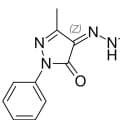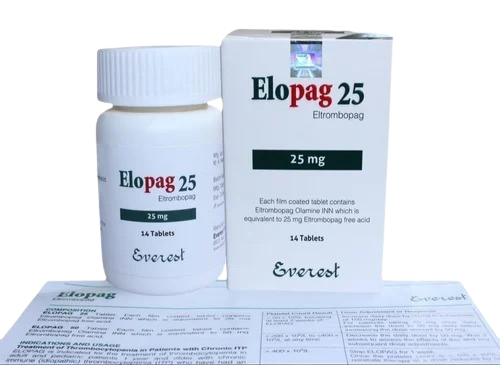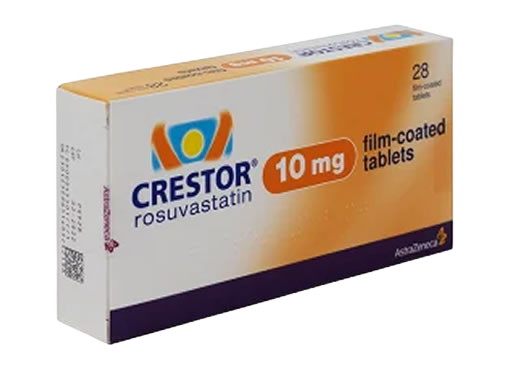Elopag 25mg 14’ct tablets Imported In Pakistan
Elopag Overview
Elopag is a medication containing Eltrombopag, a thrombopoietin receptor agonist used primarily to treat conditions associated with low platelet counts.
Indications
Elopag is indicated for:
- Chronic Immune Thrombocytopenia (ITP): For patients with persistent or chronic ITP to increase platelet counts.
- Hepatitis C-Associated Thrombocytopenia: To manage low platelet counts in patients with chronic hepatitis C.
- Severe Aplastic Anemia: Used in conjunction with standard immunosuppressive therapy.
Pharmacology
Eltrombopag works by stimulating the bone marrow to produce more platelets. It binds to the thrombopoietin receptor on megakaryocytes, initiating signaling pathways that lead to platelet production.
Dosage and Administration
- General Dosage: Typically taken once daily on an empty stomach, at least one hour before or two hours after meals.
- Initial Doses:
- For adults and pediatric patients (6 years and older) with ITP, the starting dose is usually 50 mg daily, with adjustments for Asian ancestry or hepatic impairment.
- For chronic hepatitis C, the initial dose is 25 mg daily, adjustable based on platelet counts.
- For severe aplastic anemia, dosing varies by age and weight, starting at 2.5 mg/kg for young children and up to 150 mg for older patients.
Precautions and Warnings
- Liver Monitoring: Patients with chronic hepatitis C should have liver function monitored due to potential hepatic decompensation.
- Risk of Thrombosis: There is an increased risk of thrombotic events, particularly in patients with underlying liver disease.
- Myelodysplastic Syndromes: Caution is advised due to the risk of progression to acute myeloid leukemia.
Special Populations
- Children: Safety and efficacy in children under one year have not been established.
- Pregnancy: Not recommended for use during pregnancy.
Overdose Effects
In cases of overdose, excessive platelet counts may lead to thrombotic complications. Treatment may involve administering agents to limit absorption.
Storage Conditions
Elopag should be stored in a cool, dry place, away from light, and out of reach of children. The recommended storage temperature is below 25°C.

Description
Elopag Overview
Elopag is a medication containing Eltrombopag, a thrombopoietin receptor agonist used primarily to treat conditions associated with low platelet counts.
Indications
Elopag is indicated for:
- Chronic Immune Thrombocytopenia (ITP): For patients with persistent or chronic ITP to increase platelet counts.
- Hepatitis C-Associated Thrombocytopenia: To manage low platelet counts in patients with chronic hepatitis C.
- Severe Aplastic Anemia: Used in conjunction with standard immunosuppressive therapy.
Pharmacology
Eltrombopag works by stimulating the bone marrow to produce more platelets. It binds to the thrombopoietin receptor on megakaryocytes, initiating signaling pathways that lead to platelet production.
Dosage and Administration
- General Dosage: Typically taken once daily on an empty stomach, at least one hour before or two hours after meals.
- Initial Doses:
- For adults and pediatric patients (6 years and older) with ITP, the starting dose is usually 50 mg daily, with adjustments for Asian ancestry or hepatic impairment.
- For chronic hepatitis C, the initial dose is 25 mg daily, adjustable based on platelet counts.
- For severe aplastic anemia, dosing varies by age and weight, starting at 2.5 mg/kg for young children and up to 150 mg for older patients.
Precautions and Warnings
- Liver Monitoring: Patients with chronic hepatitis C should have liver function monitored due to potential hepatic decompensation.
- Risk of Thrombosis: There is an increased risk of thrombotic events, particularly in patients with underlying liver disease.
- Myelodysplastic Syndromes: Caution is advised due to the risk of progression to acute myeloid leukemia.
Special Populations
- Children: Safety and efficacy in children under one year have not been established.
- Pregnancy: Not recommended for use during pregnancy.
Overdose Effects
In cases of overdose, excessive platelet counts may lead to thrombotic complications. Treatment may involve administering agents to limit absorption.
Storage Conditions
Elopag should be stored in a cool, dry place, away from light, and out of reach of children. The recommended storage temperature is below 25°C.
Key Benefits of Elopag
- Increases Platelet Production: Elopag stimulates the bone marrow to produce more platelets, which helps reduce the risk of bleeding in patients with low platelet counts.
- Treats Multiple Conditions: It is effective for treating chronic immune thrombocytopenia (ITP), low platelet counts associated with chronic hepatitis C, and severe aplastic anemia.
- Oral Administration: Elopag is taken orally, making it convenient for patients compared to injectable alternatives.
- Flexible Dosing: The dosage can be adjusted based on individual patient needs, allowing for personalized treatment plans.
Key Ingredients
- Eltrombopag: The active ingredient in Elopag, a small-molecule thrombopoietin (TPO) receptor agonist. Eltrombopag works by binding to the TPO receptor on megakaryocytes, promoting the production of platelets in the bone marrow.
Elopag is manufactured by Everest Pharmaceuticals Ltd and is available in 25 mg and 50 mg strengths.

Mechanism of Action
Elopag (Eltrombopag) is a thrombopoietin (TPO) receptor agonist that stimulates platelet production. Its mechanism of action involves:
- Binding to the transmembrane domain of the human TPO receptor, initiating signaling cascades that induce proliferation and differentiation of bone marrow progenitor cells.
- Activating the JAK/STAT pathway, which leads to increased platelet production. Unlike recombinant TPO or romiplostim, Eltrombopag does not activate the AKT pathway.
- Enhancing the effect of TPO in vivo, as evidenced by increased levels of other blood cell lineages in addition to platelets when used to treat aplastic anemia.
Combination with Other Medications
- Standard Immunosuppressive Therapy: Elopag is often used as a first-line therapy in combination with standard immunosuppressive treatments, such as antithymocyte globulin (equine) and cyclosporine, particularly for severe aplastic anemia.
- Chronic Hepatitis C: In patients with chronic hepatitis C, Elopag can be used alongside interferon and ribavirin. However, this combination may increase the risk of hepatic toxicity, so careful monitoring is necessary.
Potential Drug Interactions
- Increased Side Effects: Co-administration with certain medications, such as bosentan, statins (like rosuvastatin), and other drugs, may heighten the risk of side effects, including muscle pain and liver enzyme elevation. Dosage adjustments may be required.
- Decreased Effectiveness: Medications that contain polyvalent cations (e.g., antacids, supplements with calcium or magnesium) can reduce the effectiveness of Elopag. It is recommended to take Elopag at least two hours before or four hours after these products to avoid interactions.
Key Precautions with Elopag (Eltrombopag)
- Monitor Liver Function: Liver function should be monitored before and during therapy, as Elopag can cause hepatotoxicity.
- Risk of Thrombotic or Thromboembolic Complications: Elopag may increase the risk of portal vein thrombosis and other thromboembolic complications, especially in patients with chronic liver disease.
- Myelodysplastic Syndrome (MDS) Warning: Elopag should not be used in patients with MDS, as it can cause disease progression to acute myeloid leukemia (AML) and increase the risk of death.
- Allergy Warning: Elopag can cause severe allergic reactions, including trouble breathing, swelling of the throat or tongue, skin rash, and itchiness. Patients who have had an allergic reaction to Elopag should not take it again.
Dietary Restrictions
- Calcium-Rich Foods: Avoid consuming calcium-rich foods at the same time as Elopag. These foods include dairy products (milk, cheese, yogurt), calcium-fortified foods (orange juice, cereals), and certain leafy green vegetables (like spinach and collard greens).
- Timing: Take Elopag at least two hours before eating calcium-rich foods or four hours after consuming them to prevent interference with the medication’s absorption and effectiveness.
- Iron, Aluminum, Zinc, and Magnesium: Similar to calcium, products containing iron, aluminum, zinc, or magnesium (such as antacids and multivitamins) should also be avoided around the time of taking Elopag. Follow the same timing guidelines of two hours before or four hours after taking these products.
- Empty Stomach: It is recommended to take Elopag on an empty stomach, either one hour before a meal or two hours after a meal, to enhance its absorption and effectiveness.
Liver Function Effects
- Risk of Liver Dysfunction: Eltrombopag is associated with liver dysfunction in a notable percentage of patients. Studies indicate that approximately 22.4% of patients undergoing treatment may experience elevated liver enzymes, primarily alanine aminotransferase (ALT) and total bilirubin levels.
- Types of Liver Dysfunction: The liver dysfunction observed can range from mild to moderate. Most cases are classified as grade 1, with fewer cases reaching grades 2 or 3. Acute drug-induced hepatocellular injury has been reported in some patients.
- Monitoring Requirements: Due to the risk of hepatotoxicity, regular monitoring of liver function tests is essential before and during treatment with Elopag. This includes checking levels of ALT, AST, alkaline phosphatase (ALP), and total bilirubin.
- Comorbid Conditions: Patients with pre-existing liver conditions, such as type 2 diabetes or noninflammatory hepatobiliary diseases (e.g., gallbladder stones, fatty liver), are at a higher risk for developing liver dysfunction while on Elopag.
- Management of Liver Dysfunction: If liver dysfunction occurs, healthcare providers may need to adjust the dosage of Elopag or discontinue its use altogether, depending on the severity of the liver impairment.
Dosage of Elopag
- General Dosage: Elopag is typically taken once daily on an empty stomach, at least one hour before or two hours after meals.
- Starting Dosage:
- Adults: The starting dose is usually 50 mg for chronic immune thrombocytopenia (ITP) and can be adjusted based on platelet counts.
- Children (2 years and older): The initial dose varies by age and weight, starting at 2.5 mg/kg.
- Dosage Adjustments: Adjustments can be made in increments of 50 mg every two weeks, depending on the patient’s response and platelet levels.
- Maximum Dosage: The maximum recommended dosage is 150 mg once daily for adults and up to 75 mg for children aged 6-11 years.
Storage of Elopag
- Temperature: Store Elopag at room temperature, below 30°C (86°F).
- Conditions: Keep the tablets in a cool, dry place, away from light and moisture. Ensure they are kept in their original container.
- Safety: Store out of reach of children and do not use after the expiration date.
Reviews and Considerations
- Effectiveness: Many patients report positive outcomes in increasing platelet counts and reducing bleeding risks associated with conditions like ITP and aplastic anemia.
- Side Effects: Common side effects include nausea, fatigue, headache, and potential liver enzyme elevation. Serious side effects can occur, necessitating regular monitoring of liver function.
- Patient Experiences: Reviews often highlight the importance of adherence to dietary restrictions and monitoring to maximize the drug’s effectiveness and minimize risks.
Combination with Other Medications
- Possible Use with Other Therapies: Elopag may be used as part of combination therapy for conditions like chronic immune thrombocytopenia (ITP) and severe aplastic anemia. It can be combined with standard immunosuppressive treatments.
Potential Drug Interactions
- Increased Risk of Side Effects: Taking Elopag with certain medications can increase the risk of side effects. Examples include:
- Bosentan
- Ezetimibe
- Glyburide
- Olmesartan
- Repaglinide
- Rifampin
- Valsartan
- Imatinib
- Irinotecan
- Lapatinib
- Methotrexate
- Mitoxantrone
- Sulfasalazine
- Topotecan
These medications may require dosage adjustments to mitigate side effects, such as muscle pain when taken with cholesterol-lowering drugs like rosuvastatin and atorvastatin.
- Decreased Effectiveness: Certain products can reduce the effectiveness of Elopag. These include:
- Antacids
- Vitamins or supplements containing calcium, aluminum, iron, selenium, zinc, or magnesium
To avoid these interactions, it is recommended to take Elopag at least two hours before or four hours after these products.








Reviews
There are no reviews yet.